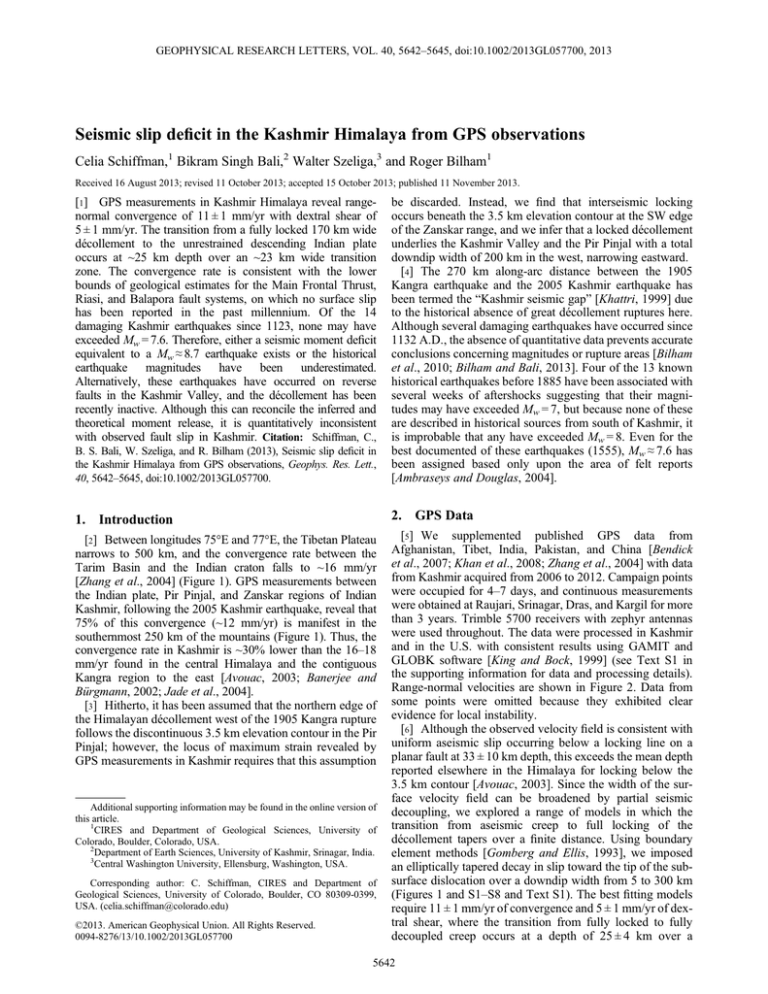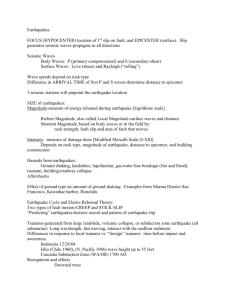
GEOPHYSICAL RESEARCH LETTERS, VOL. 40, 5642–5645, doi:10.1002/2013GL057700, 2013
Seismic slip deficit in the Kashmir Himalaya from GPS observations
Celia Schiffman,1 Bikram Singh Bali,2 Walter Szeliga,3 and Roger Bilham1
Received 16 August 2013; revised 11 October 2013; accepted 15 October 2013; published 11 November 2013.
B. S. Bali, W. Szeliga, and R. Bilham (2013), Seismic slip deficit in
the Kashmir Himalaya from GPS observations, Geophys. Res. Lett.,
40, 5642–5645, doi:10.1002/2013GL057700.
be discarded. Instead, we find that interseismic locking
occurs beneath the 3.5 km elevation contour at the SW edge
of the Zanskar range, and we infer that a locked décollement
underlies the Kashmir Valley and the Pir Pinjal with a total
downdip width of 200 km in the west, narrowing eastward.
[4] The 270 km along-arc distance between the 1905
Kangra earthquake and the 2005 Kashmir earthquake has
been termed the “Kashmir seismic gap” [Khattri, 1999] due
to the historical absence of great décollement ruptures here.
Although several damaging earthquakes have occurred since
1132 A.D., the absence of quantitative data prevents accurate
conclusions concerning magnitudes or rupture areas [Bilham
et al., 2010; Bilham and Bali, 2013]. Four of the 13 known
historical earthquakes before 1885 have been associated with
several weeks of aftershocks suggesting that their magnitudes may have exceeded Mw = 7, but because none of these
are described in historical sources from south of Kashmir, it
is improbable that any have exceeded Mw = 8. Even for the
best documented of these earthquakes (1555), Mw ≈ 7.6 has
been assigned based only upon the area of felt reports
[Ambraseys and Douglas, 2004].
1. Introduction
2. GPS Data
[2] Between longitudes 75°E and 77°E, the Tibetan Plateau
narrows to 500 km, and the convergence rate between the
Tarim Basin and the Indian craton falls to ~16 mm/yr
[Zhang et al., 2004] (Figure 1). GPS measurements between
the Indian plate, Pir Pinjal, and Zanskar regions of Indian
Kashmir, following the 2005 Kashmir earthquake, reveal that
75% of this convergence (~12 mm/yr) is manifest in the
southernmost 250 km of the mountains (Figure 1). Thus, the
convergence rate in Kashmir is ~30% lower than the 16–18
mm/yr found in the central Himalaya and the contiguous
Kangra region to the east [Avouac, 2003; Banerjee and
Bürgmann, 2002; Jade et al., 2004].
[3] Hitherto, it has been assumed that the northern edge of
the Himalayan décollement west of the 1905 Kangra rupture
follows the discontinuous 3.5 km elevation contour in the Pir
Pinjal; however, the locus of maximum strain revealed by
GPS measurements in Kashmir requires that this assumption
[5] We supplemented published GPS data from
Afghanistan, Tibet, India, Pakistan, and China [Bendick
et al., 2007; Khan et al., 2008; Zhang et al., 2004] with data
from Kashmir acquired from 2006 to 2012. Campaign points
were occupied for 4–7 days, and continuous measurements
were obtained at Raujari, Srinagar, Dras, and Kargil for more
than 3 years. Trimble 5700 receivers with zephyr antennas
were used throughout. The data were processed in Kashmir
and in the U.S. with consistent results using GAMIT and
GLOBK software [King and Bock, 1999] (see Text S1 in
the supporting information for data and processing details).
Range-normal velocities are shown in Figure 2. Data from
some points were omitted because they exhibited clear
evidence for local instability.
[6] Although the observed velocity field is consistent with
uniform aseismic slip occurring below a locking line on a
planar fault at 33 ± 10 km depth, this exceeds the mean depth
reported elsewhere in the Himalaya for locking below the
3.5 km contour [Avouac, 2003]. Since the width of the surface velocity field can be broadened by partial seismic
decoupling, we explored a range of models in which the
transition from aseismic creep to full locking of the
décollement tapers over a finite distance. Using boundary
element methods [Gomberg and Ellis, 1993], we imposed
an elliptically tapered decay in slip toward the tip of the subsurface dislocation over a downdip width from 5 to 300 km
(Figures 1 and S1–S8 and Text S1). The best fitting models
require 11 ± 1 mm/yr of convergence and 5 ± 1 mm/yr of dextral shear, where the transition from fully locked to fully
decoupled creep occurs at a depth of 25 ± 4 km over a
[1] GPS measurements in Kashmir Himalaya reveal rangenormal convergence of 11 ± 1 mm/yr with dextral shear of
5 ± 1 mm/yr. The transition from a fully locked 170 km wide
décollement to the unrestrained descending Indian plate
occurs at ~25 km depth over an ~23 km wide transition
zone. The convergence rate is consistent with the lower
bounds of geological estimates for the Main Frontal Thrust,
Riasi, and Balapora fault systems, on which no surface slip
has been reported in the past millennium. Of the 14
damaging Kashmir earthquakes since 1123, none may have
exceeded Mw = 7.6. Therefore, either a seismic moment deficit
equivalent to a Mw ≈ 8.7 earthquake exists or the historical
earthquake magnitudes have been underestimated.
Alternatively, these earthquakes have occurred on reverse
faults in the Kashmir Valley, and the décollement has been
recently inactive. Although this can reconcile the inferred and
theoretical moment release, it is quantitatively inconsistent
with observed fault slip in Kashmir. Citation: Schiffman, C.,
Additional supporting information may be found in the online version of
this article.
1
CIRES and Department of Geological Sciences, University of
Colorado, Boulder, Colorado, USA.
2
Department of Earth Sciences, University of Kashmir, Srinagar, India.
3
Central Washington University, Ellensburg, Washington, USA.
Corresponding author: C. Schiffman, CIRES and Department of
Geological Sciences, University of Colorado, Boulder, CO 80309-0399,
USA. (celia.schiffman@colorado.edu)
©2013. American Geophysical Union. All Rights Reserved.
0094-8276/13/10.1002/2013GL057700
5642
SCHIFFMAN ET AL.: KASHMIR GPS SEISMIC SLIP DEFICIT
Figure 1. (a) India-fixed velocities with 95% error ellipses showing location of tapered décollement slip. MFT = Main
Frontal Thrust, RF = Riasi fault, BF = Balapora fault, LL = locking line, FC = fully creeping, kf = Karakoram fault. SW/NE
dashed line indicates the cross section in Figure 1b. (b) Schematic cross section showing location of faults, published slip rates
(mm/yr), hypothetical rupture termination points T1–T5, LL, and FC used in Table 1 and location of tapered slip. Inset shows
R2 values (percentage of variance explained by the model) for varying the depth and horizontal position of the end point (LL)
of tapered slip along the line of section in Figure 1a. See supporting information for details.
downdip width of ~23 km. None of our elastic models permit
significant creep (<1 mm/yr) beneath the Kashmir Valley.
[7] A remarkable feature in the data is the presence of
~6 mm/yr of dextral shear parallel to the Zanskar range
which, although weakly constrained to the same maximum
strain gradient as the convergence signal (Figure S8), suggests that an oblique slip deficit (N175°W) is developing
along the SW edge of the Zanskar Range at 12.5 ± 1 mm/yr.
With the exception of the Karakoram fault [Jade et al.,
2004], no prominent dextral faulting has been reported
nearby, and it appears probable to us that NW trending faults
that have been identified south of the Zanskar may include a
component of oblique slip.
3. Structure and Faulting
[8] Three significant fault systems accommodate convergence
between the Zanskar range and the Indian craton (Figure 2).
[9] No surface faulting has been reported from the Main
Frontal Thrust (MFT) at the foot of the Pir Pinjal.
Anticlinal structures here suggest that convergence in the
past 15 kyr at 2–6 mm/yr has been accommodated by folding
of surface sediments [Vignon, 2011].
[10] A 70 km long strand of the Riasi fault dips 45°NE on
the SE flank of the Pir Pinjal (Figure 2) and has been
interpreted to represent the southeast extension of the
Balakot-Bagh fault [Shah, 2013; Thakur et al., 2010;
Vignon, 2011]. Vignon [2011] reported a N/S shortening rate
of 10 ± 2 mm/yr near Riasi assuming an ~E/W strike and a
45° dip.
[11] The ~40 km long Balapora reverse fault dips ~60°NE
near the surface and forms one of three conspicuous scarps that
offset Karewa sediments in the SE Kashmir Valley [Ahmad
et al., 2013; Shah, 2013]. Paleoseismic investigations of the
Balapora fault reveal a shortening rate of 0.3–1.3 mm/yr.
The date of the most recent slip on the Balapora fault is
5643
SCHIFFMAN ET AL.: KASHMIR GPS SEISMIC SLIP DEFICIT
Figure 2. The Himalaya between the 2005 Kashmir and
1905 Kangra rupture zones. Segment boundaries (wavy
lines) between areas A, B, and C are defined in text. Grid
indicates region of tapered slip. Arrows indicate mean GPS
India fixed vector. Symbols are as denoted in Figure 1.
Dashed lines indicate inferred surface faults [Shah, 2013].
OF = Oldham fault [Bilham et al., 2013]. Seismicity
1973–2013 from the USGS/PDE Global Catalog (http://
earthquake.usgs.gov/research/data/pde.php).
probably >1 kyr [Meigs et al., 2012]. Vignon [2011]
interpreted the Balapora fault as a wedge thrust overlying a
SE dipping antithetic fault (dashed line in Figure 1b). It is possible that the slip of the Balapora fault primarily records
flexure of the Kashmir Basin [Burbank and Johnson, 1983]
and thus provides a misleading measure of the convergence
between the Zanskar range and the descending Indian plate.
[12] The lower range of these combined shortening rates
(15 ± 5 mm/yr) is consistent with our observed oblique convergence rate of 12.5 ± 1 mm/yr (Figure 1), but since none
of these faults are reported to have slipped in the past 900
years, a current slip deficit of >11 m may exist.
4. Discussion: Rupture Scenarios
[13] In Figure 2, we identify several possible rupture segments in the region between the 2005 Kashmir Mw = 7.6
earthquake and the 1905 Kangra Mw = 7.8 earthquake. The
locking zone beneath the Zanskar range is considered the
northern limit of décollement rupture, and the southern limit
follows the foothills of the Pir Pinjal. We consider slip from
the locking line to the surface Balapora and Riasi fault
systems and to the MFT and partial slip on the décollement
terminated at the base of these faults (Figure 1b, T1–T5).
[14] We invoke two broad tectonic features that may act to
arrest along-strike rupture (Figure 2). The segment boundary
between A and B is suggested by the river drainage in the SE
Kashmir Valley and by the reentrant near Riasi that is typical
of folding associated with a sea mount being underthrust
beneath an accretionary wedge [Schiffman et al., 2011].
The segment boundary between B and C is identified by
the abrupt westward reduction of seismic productivity between Kishtwar and the Kashmir Valley and a suite of normal
faults along the crest of the range that separates these two
regions [Schiffman et al., 2011; Bilham et al., 2013].
[15] We next consider the rupture of each of these fault
patches in isolation, or contiguously in unison, applying scaling laws, guided by observed slip in great Himalayan earthquakes [Kumar et al., 2006] to anticipate fault slip for each
combination of along-strike length and downdip width. The
resulting matrix of Mmax values from 7.3 > Mw > 9.0 is
shown in Table 1.
[16] We note that Mmax for very few segment combinations
calculated in Table 1 are compatible with the historical
record of inferred Mw ≤ 7.6 earthquakes. In particular,
there is no precedence for a M > 8 multisegmented alongstrike rupture of the entire region between Kangra and
Muzaffarabad. The summed seismic moment, assuming that
all 13 pre-1885 earthquakes were Mw = 7.6, amounts to 3.8 ×
1028 dyn cm, whereas the cumulative seismic moment since
the 1123 earthquake for the entire décollement (A, B, and
C in Figure 2) is ≈1.3 × 1029 dyn cm, with a slip deficit of
11 m and a moment deficit equivalent to a single Mw = 8.7
earthquake. Since no creep is manifest SW of the locking
line, we would conclude that one or more earthquakes with
8.2 < Mw < 8.6 are either missing from the 900 yearlong historical earthquake record or will occur in the future.
[17] This calculation, however, follows the traditional
view that the décollement from the locking line to the MFT
represents the active plate boundary and makes no allowance
for the possibility that reverse faults in the Kashmir Valley
have transiently “short-circuited” the 11 mm/yr convergence
signal in the past millennium. Thus, supposing that the
Balapora system of thrust faults extends throughout segments A–C and that the décollement to its SE has been
recently inactive, the anticipated seismic moment release
for the past 900 years for this 270 × 50 km2 area would be
Table 1. Estimated Mmax Associated With Segmental or Complete Slip of the Kashmir Seismic Gap [Khattri, 1999]a
Segment
LL-BF
LL-RF
LL-MFT
FC-MFT
FC-RF
T5-BFsurface
T3-RFsurface
LL-T3
LL-T4
Width
A = 100 km
B = 70 km
C = 100 km
A + B = 170 km
B + C = 170 km
A + B + C = 270 km
50
135
170
200
170
30
25
20
30
7.7 (2)
8.3 (6)
8.5 (10)
8.6 (12)
8.5 (10)
7.5 (2)
7.8 (5)
7.4 (2)
7.8 (5)
7.6 (2)
8.1 (6)
8.4 (10)
8.5 (12)
8.4 (10)
7.4 (2)
7.7 (5)
7.3 (2)
7.7 (5)
8.3 (6)
8.4 (10)
8.5 (12)
8.0 (2)
8.6 (10)
8.7 (15)
8.8 (15)
8.7 (15)
8.6 (10)
8.6 (15)
8.5 (15)
8.8 (15)
8.9 (20)
9.0 (25)
7.8 (5)
8.4 (7)
7.7 (5)
a
Estimated Mmax values are calculated for rupture between downdip features L1-FC in Figure 1b and along-strike segments in Figure 2. Slips in parentheses
(m) are from scaling laws. Not all combinations of slip and rupture area are considered. The width of the décollement (column 2, in km) halves eastward.
Maximum slip (23 m) has been reported in the western Himalaya [Kumar et al., 2006], but no paleoseismic slip has been recorded from the Pir Pinjal MFT.
5644
SCHIFFMAN ET AL.: KASHMIR GPS SEISMIC SLIP DEFICIT
4.4 × 1028 dyn cm, close to that inferred above. However, this
would require branches of the Balapora fault system each to
have slipped 2–4 m in 13 earthquakes distributed along the
range, for which there is no evidence. No surface faulting
in the past millennium has yet been reported on any faults
in the Kashmir Valley.
5. Conclusions
[18] We report range-normal convergence of 11 ± 1 mm/yr
and dextral shear of 5 ± 1 mm/yr beneath the Zanskar range,
with total oblique convergence of 12.5 mm/yr at ~N175°W.
A 23 km wide transition zone on the Himalayan décollement
separates a fully locked 170 km wide décollement from the
unrestrained descending Indian plate at 25–30 km depth.
No creep occurs beneath the Kashmir Valley. Geological slip
rates reported on the Balapora, Riasi, and MFT faults in the
past 15–40 kyr are quantitatively consistent (0.8 ± 0.5, 10 ± 2,
and 4 ± 2 mm/yr, respectively) with our observations, and
therefore, it is probable that these faults absorb the entire
long-term convergence signal.
[19] Since no surface slip is reported to have occurred in
the past millennium, we may conclude that a slip deficit of
~11 m exists. If the entire décollement, or ~250 km of the
Riasi fault, were to slip 11 m slip between 74 and 76°E,
it would result in a 8.5 < Mw < 8.7 earthquake. The maximum slip recorded on the MFT to the east is ~23 m
[Kumar et al., 2006]; hence, Mmax for a Kashmir gap-filling
earthquake could be 8.8 < Mw < 9.0. Although the recurrence interval for such earthquakes would be ~1200 years
on the Riasi fault and >1800 years on the MFT, no quantitative evidence for such a large earthquake is currently
known in Kashmir’s history.
[20] However, if we consider that the plate boundary has
been recently short-circuited by reverse faults in the
Kashmir Valley and that the Riasi fault and the frontal
fold system have been inactive in recent history, then
14 Mw ≈ 7.6 earthquakes would be sufficient to satisfy the
lower anticipated cumulative moment release. Arguing
against this alternative interpretation, of the 14 damaging
earthquakes that have occurred in 1123–1885, only the
1555 earthquake is believed to have been Mw ~ 7.6; none
have resulted in observed surface slip, and it is possible that
the faults in the Kashmir Valley are secondary features that
do not actively participate in underthrusting of the Indian
plate. Since 1555, damaging earthquakes have been reported
in the Kashmir Valley with a mean recurrence interval of
29 ± 27 years, and it is now 128 years since the most recent
(Mw = 6.5 in Baramula). The absence of a recent damaging
earthquake suggests that a 6.5 < Mw < 7.6 earthquake in the
valley should be anticipated, and a much larger earthquake,
though of low probability, cannot yet be excluded.
[21] Acknowledgments. The measurements were made possible by a
collaborative project between the University of Colorado and the University
of Kashmir. Funding was awarded by the National Science Foundation
EAR 0739081.
[22] The Editor thanks Leonardo Seeber and Laurent Bollinger for their
assistance in evaluating this paper.
References
Ahmad, S., M. I. Bhat, C. Madden, and B. S. Bali (2013), Geomorphic
analysis reveals active tectonic deformation on the eastern flank of the
Pir Panjal Range, Kashmir Valley, India, Arabian J. Geosci., 6(3), 1–11,
doi:10.1007/s12517-013-0900-y.
Ambraseys, N., and J. Douglas (2004), Magnitude calibration of north Indian
earthquakes, Geophys. J. Int., 159(1), 165–206, doi:10.1111/j.1365246X.2004.02323.x.
Avouac, J. P. (2003), Mountain building, erosion, and the seismic cycle in the
Nepal Himalaya, in Advances in Geophysics, vol. 46, edited by R. Dmowska,
pp. 1–80, Elsevier, San Diego, Calif., doi:10.1016/S0065-2687(03)46001-9.
Banerjee, P., and R. Bürgmann (2002), Convergence across the northwest
Himalaya from GPS measurements, Geophys. Res. Lett., 29(13), 1652,
doi:10.1029/2002GL015184.
Bendick, R., R. Bilham, M. A. Khan, and S. F. Khan (2007), Slip on an active wedge thrust from geodetic observations of the 8 October 2005
Kashmir earthquake, Geology, 35(3), 267–270, doi:10.1130/G23158A.1.
Bilham, R., and B. S. Bali (2013), A ninth century earthquake-induced
landslide and flood in the Kashmir Valley, and earthquake damage
to Kashmir’s medieval temples, Bull. Earthquake Eng., 11(4), 1–31,
doi:10.1007/s10518-013-9504-x.
Bilham, R., B. S. Bali, M. I. Bhat, and S. Hough (2010), Historical
earthquakes in Srinagar, Kashmir: Clues from the Shiva Temple at
Pandrethan, in Ancient Earthquakes, edited by M. Sintubin, et al., pp.
107–117, Geol. Soc. of Am., Boulder, Colo., doi:10.1130/2010.2471(10).
Bilham, R., B. S. Bali, S. Ahmad, and C. R. Schiffman (2013), Oldham’s Lost
Fault, Seismol. Res. Lett., 84(4), 702–710, doi:10.1785/0220130036.
Burbank, D. W., and G. D. Johnson (1983), The late Cenozoic chronologic
and stratigraphic development of the Kashmir intermontane basin,
northwestern Himalaya, Palaeogeogr. Palaeoclimatol. Palaeoecol.,
43(3), 205–235.
Gomberg, J. S., and M. Ellis (1993), 3D-DEF: A User’s Manual
(A Three-Dimensional, Boundary Element Modeling Program), 15 pp.,
U.S. Geol. Surv., Denver, Colo.
Jade, S., B. Bhatt, Z. Yang, R. Bendick, V. Gaur, P. Molnar, M. Anand, and
D. Kumar (2004), GPS measurements from the Ladakh Himalaya, India:
Preliminary tests of plate-like or continuous deformation in Tibet, Geol.
Soc. Am. Bull., 116(11–12), 1385–1391, doi:10.1130/B25357.1.
Khan, M. A., R. Bendick, M. I. Bhat, R. Bilham, D. M. Kakar, S. F. Khan,
S. H. Lodi, M. S. Qazi, B. Singh, and W. Szeliga (2008), Preliminary
geodetic constraints on plate boundary deformation on the western edge
of the Indian plate from TriGGnet (Tri-University GPS Geodesy
Network), J. Himalayan Earth Sci., 41, 71–87.
Khattri, K. (1999), Probabilities of occurrence of great earthquakes in the
Himalaya, Proc. Indian Acad. Sci., 108(2), 87–92.
King, R. W., and Y. Bock (1999), Documentation for the GAMIT GPS
analysis software, MIT, Cambridge, Mass.
Kumar, S., S. G. Wesnousky, T. K. Rockwell, R. W. Briggs, V. C. Thakur,
and R. Jayangondaperumal (2006), Paleoseismic evidence of great surface
rupture earthquakes along the Indian Himalaya, J. Geophys. Res., 111,
B03304, doi:10.1029/2004JB003309.
Meigs, A., C. Madden, J. Yule, Y. Gavillot, A. Hebeler, A. Hussain, M. Bhat,
A. Kausar, M. Malik, and S. Ramzan (2012), Pattern, rate, and timing of surface rupturing earthquakes across the northwest Himalaya, J. Himalayan
Earth Sci., 45(2), 111–114.
Schiffman, C. R., B. S. Bali, and R. Bilham (2011), Seismic hazard implications of a vanished Punjab Mountain rammed 100 km beneath the southeast end of the Kashmir Valley, Abstract T54B-05 presented at 2011 Fall
Meeting, AGU, San Francisco, Calif., 5–9 Dec.
Shah, A. A. (2013), Earthquake geology of Kashmir Basin and its implications for future large earthquakes, Int. J. Earth Sci., 102(7), 1957–1966,
doi:10.1007/s00531-013-0874-8.
Thakur, V. C., R. Jayangondaperumal, and M. A. Malik (2010), Redefining
Medlicott-Wadia’s main boundary fault from Jhelum to Yamuna: An
active fault strand of the main boundary thrust in northwest Himalaya,
Tectonophysics, 489(1–4), 29–42, doi:10.1016/j.tecto.2010.03.014.
Vignon, V. (2011), Activité hors séquence des chevauchements dans la
syntaxe nord-ouest himalayenne: Apports de la modélisation analogique
et quantification quaternaire par analyse morphotectonique, PhD thesis,
Univ. de Grenoble, France.
Zhang, P.-Z., Z. Shen, M. Wang, W. Gan, R. Burgmann, P. Molnar,
Q. Wang, Z. Niu, J. Sun, and J. Wu (2004), Continuous deformation of
the Tibetan Plateau from global positioning system data, Geology,
32(9), 809–812, doi:10.1130/G20554.1.
5645






